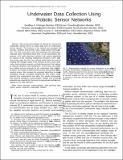| dc.contributor.author | Hollinger, Geoffrey A. | |
| dc.contributor.author | Choudhary, Sunav | |
| dc.contributor.author | Qarabaqi, Parastoo | |
| dc.contributor.author | Murphy, Christopher | |
| dc.contributor.author | Mitra, Urbashi | |
| dc.contributor.author | Sukhatme, Gaurav S. | |
| dc.contributor.author | Stojanovic, Milica | |
| dc.contributor.author | Singh, Hanumant | |
| dc.contributor.author | Hover, Franz S. | |
| dc.date.accessioned | 2014-06-10T18:44:52Z | |
| dc.date.available | 2014-06-10T18:44:52Z | |
| dc.date.issued | 2012-06 | |
| dc.date.submitted | 2012-04 | |
| dc.identifier.issn | 0733-8716 | |
| dc.identifier.uri | http://hdl.handle.net/1721.1/87723 | |
| dc.description.abstract | We examine the problem of utilizing an autonomous underwater vehicle (AUV) to collect data from an underwater sensor network. The sensors in the network are equipped with acoustic modems that provide noisy, range-limited communication. The AUV must plan a path that maximizes the information collected while minimizing travel time or fuel expenditure. We propose AUV path planning methods that extend algorithms for variants of the Traveling Salesperson Problem (TSP). While executing a path, the AUV can improve performance by communicating with multiple nodes in the network at once. Such multi-node communication requires a scheduling protocol that is robust to channel variations and interference. To this end, we examine two multiple access protocols for the underwater data collection scenario, one based on deterministic access and another based on random access. We compare the proposed algorithms to baseline strategies through simulated experiments that utilize models derived from experimental test data. Our results demonstrate that properly designed communication models and scheduling protocols are essential for choosing the appropriate path planning algorithms for data collection. | en_US |
| dc.description.sponsorship | United States. Office of Naval Research (ONR N00014-09-1-0700) | en_US |
| dc.description.sponsorship | United States. Office of Naval Research (ONR N00014-07-1-00738) | en_US |
| dc.description.sponsorship | National Science Foundation (U.S.) (NSF 0831728) | en_US |
| dc.description.sponsorship | National Science Foundation (U.S.) (NSF CCR-0120778) | en_US |
| dc.description.sponsorship | National Science Foundation (U.S.) (NSF CNS-1035866) | en_US |
| dc.language.iso | en_US | |
| dc.publisher | Institute of Electrical and Electronics Engineers (IEEE) | en_US |
| dc.relation.isversionof | http://dx.doi.org/10.1109/jsac.2012.120606 | en_US |
| dc.rights | Creative Commons Attribution-Noncommercial-Share Alike | en_US |
| dc.rights.uri | http://creativecommons.org/licenses/by-nc-sa/4.0/ | en_US |
| dc.source | Prof. Hover via Angie Locknar | en_US |
| dc.title | Underwater Data Collection Using Robotic Sensor Networks | en_US |
| dc.type | Article | en_US |
| dc.identifier.citation | Hollinger, Geoffrey A., Sunav Choudhary, Parastoo Qarabaqi, Christopher Murphy, Urbashi Mitra, Gaurav S. Sukhatme, Milica Stojanovic, Hanumant Singh, and Franz Hover. “Underwater Data Collection Using Robotic Sensor Networks.” IEEE Journal on Selected Areas in Communications 30, no. 5 (n.d.): 899–911. | en_US |
| dc.contributor.department | Massachusetts Institute of Technology. Department of Mechanical Engineering | en_US |
| dc.contributor.approver | Hover, Franz S. | en_US |
| dc.contributor.mitauthor | Hover, Franz S. | en_US |
| dc.relation.journal | IEEE Journal on Selected Areas in Communications | en_US |
| dc.eprint.version | Author's final manuscript | en_US |
| dc.type.uri | http://purl.org/eprint/type/JournalArticle | en_US |
| eprint.status | http://purl.org/eprint/status/PeerReviewed | en_US |
| dspace.orderedauthors | Hollinger, Geoffrey A.; Choudhary, Sunav; Qarabaqi, Parastoo; Murphy, Christopher; Mitra, Urbashi; Sukhatme, Gaurav S.; Stojanovic, Milica; Singh, Hanumant; Hover, Franz | en_US |
| dc.identifier.orcid | https://orcid.org/0000-0002-2621-7633 | |
| mit.license | OPEN_ACCESS_POLICY | en_US |
| mit.metadata.status | Complete | |
